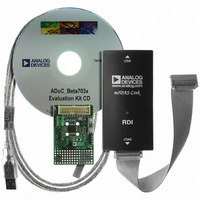EVAL-ADUC7032QSPZ Analog Devices Inc, EVAL-ADUC7032QSPZ Datasheet - Page 108

EVAL-ADUC7032QSPZ
Manufacturer Part Number
EVAL-ADUC7032QSPZ
Description
EVAL DEV QUICK START ADUC7032
Manufacturer
Analog Devices Inc
Series
QuickStart™ PLUS Kitr
Type
MCUr
Datasheet
1.EVAL-ADUC7032QSPZ.pdf
(116 pages)
Specifications of EVAL-ADUC7032QSPZ
Contents
Evaluation Board, Power Supply, Cable, Software, Emulator and Documentation
For Use With/related Products
ADuC7032
Lead Free Status / RoHS Status
Lead free / RoHS Compliant
- Current page: 108 of 116
- Download datasheet (3Mb)
ADuC7032-8L
Example LIN Hardware Synchronization Routine
Consider the following C-source code LIN initialization routine:
void LIN_INIT(void )
{
}
Using this configuration, LHSVAL1 begins to count on the first
falling edge received on the LIN bus. If LHSVAL1 exceeds the
value written to LHSVAL1, in this case 0x3F, a break compare
interrupt is generated.
On the next falling edge, LHSVAL0 begins counting. LHSVAL0
monitors the number of falling edges and compares this number
to the value written to LHSCON1. In this example, the edge to
monitor is the sixth falling edge of the LIN frame, or the fifth
falling edge of the sync byte.
char HVstatus;
GP2CON = 0x110000;
LHSCON0 = 0x1;
do{
while (!(HVstatus & 0x4));
while((LHSSTA & 0x20) == 0 )
{
}
LHSCON1 = 0x062;
LHSCON0 = 0x0114;
LHSVAL1 = 0x03F;
HVDAT = 0x02;
HVCON = 0x08;
}
do{
while(HVstatus & 0x1); // Wait until command is finished
}
HVstatus = HVCON;
// Enable LHS on GPIO pins
// Reset LHS interface
// Enable normal LIN TX mode
// Write to Config0
// Transmit command is correct
// Wait until the LHS hardware is reset
// Sets stop edge as the fifth falling edge
// and the start edge as the first falling
// edge in the sync byte
// Gates UART RX line, ensure no interference
// from the LIN into the UART
// Selects the stop condition as a falling edge
// Enables generation of an interrupt on the
// stop condition
// Enables the interface
// Set number of 131 kHz periods to generate
// a break interrupt 0x3F / 131 kHz ~ 480 µs
// which is just over 9.5 tbits
Rev.0 | Page 108 of 116
After the number of falling edges is received, a stop condition
interrupt is generated. It is at this point that the UART is
configured to receive the protected identifier.
The UART must not be ungated, through LHSCON0[8], before
the LIN bus returns high. If this occurs, UART communication
errors may occur. This process is shown in detail in Figure 44.
Example code follows.
Related parts for EVAL-ADUC7032QSPZ
Image
Part Number
Description
Manufacturer
Datasheet
Request
R

Part Number:
Description:
IC, ADJ LDO REG, 1.5V TO 5V 250mA MSOP-8
Manufacturer:
Vishay
Datasheet:

Part Number:
Description:
IC, ADJ LDO REG, 1.5V TO 5V 0.6A 8-TSSOP
Manufacturer:
Vishay
Datasheet:

Part Number:
Description:
IC, ADJ LDO REG, 1.5V TO 5V 250mA MSOP-8
Manufacturer:
Vishay
Datasheet:

Part Number:
Description:
IC ADJ LDO REG 1.5V TO 5V 150mA 5-SOT-23
Manufacturer:
Vishay
Datasheet:

Part Number:
Description:
BOARD EVAL AS1324-AD
Manufacturer:
austriamicrosystems
Datasheet:

Part Number:
Description:
IC, ADJ LDO REG, 1.5V TO 5V 0.6A 8-TSSOP
Manufacturer:
Vishay
Datasheet:

Part Number:
Description:
IC, ADJ LDO REG, 1.5V TO 5V, 0.3A, MSOP8
Manufacturer:
Vishay
Datasheet:

Part Number:
Description:
IC, ADJ LDO REG, 1.5V TO 5V, 0.3A, MSOP8
Manufacturer:
Vishay
Datasheet:

Part Number:
Description:
IC, ADJ LDO REG 1.215V TO 5V 0.3A MSOP-8
Manufacturer:
Vishay
Datasheet:

Part Number:
Description:
IC, ADJ LDO REG 1.215V TO 5V 0.3A MSOP-8
Manufacturer:
Vishay
Datasheet:

Part Number:
Description:
±1.7g Dual-Axis IMEMS Accelerometer Evaluation Board
Manufacturer:
Analog Devices Inc
Datasheet:

Part Number:
Description:
IC MULTIPLIER ANALOG 8-SOIC T/R
Manufacturer:
Analog Devices Inc
Datasheet:

Part Number:
Description:
IC ANALOG MULTIPLIER 8-DIP
Manufacturer:
Analog Devices Inc
Datasheet:

Part Number:
Description:
IC ANALOG MULTIPLIER 8-SOIC
Manufacturer:
Analog Devices Inc
Datasheet:

Part Number:
Description:
IC ANALOG MULTIPLIER 8-DIP
Manufacturer:
Analog Devices Inc
Datasheet:










